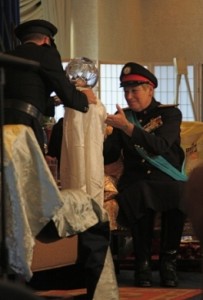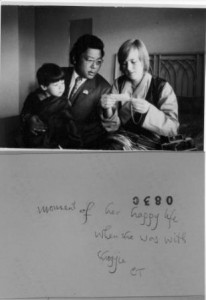Monday
Dharma Teachings, Sakyong and FamilyBasic Space: Manifesting the Feminine Principle

Druk Sakyong Wangmo, Lady Diana Mukpo, at last year's Shambhala Investiture. Photo courtesy of Helen Vink.
I am delighted to contribute a few words about the meaning and the importance of the role of the Sakyong Wangmo, based on my perspective as the first Sakyong Wangmo of the Kingdom. I hope that there will be many Sakyong Wangmos in the generations to come, for as long as our Shambhala lineage continues. Each person who fills this role will have a different nature and different inclinations. Therefore, each Sakyong Wangmo will have a unique way of manifesting. However, all of the holders of this lineage are linked by a common denominator, which is their service to the Sakyong and their service to the Shambhala world all together. Although the manifestations may be distinct, all have this common bond and burden.
The Sakyong Wangmo must have unwavering conviction and trust in the Shambhala vision. Nurturing the Shambhala world is the duty of the Sakyong Wangmo and it is an ongoing responsibility. This responsibility is a lifelong burden. Once taken up, it cannot be put down.
The Sakyong Wangmo is the embodiment of feminine principle in the Kingdom. She provides the basic space in which communication can take place. A male-dominated society that does not have the Sakyong Wangmo principle operating within it would be a very difficult and unpleasant society to live in or to govern. So, through the aspect of communication, the Sakyong Wangmo harvests peace throughout the Kingdom. This requires clarity and the wisdom of the monarch’s view on her part. The activity of harvesting peace is actualizing the Four Dignities and implementing the Four Karmas on behalf of all the citizens of Shambhala. Thus, the Sakyong Wangmo promotes enlightened leadership within Shambhala, which is necessary to achieve true harmony in the society. This is the true meaning of harvesting peace, which involves a step-by-step process of fulfilling whatever is needed in a situation. It is accommodation in a powerful sense.
It is very important for the citizens in Shambhala to have a good understanding of the relationship of the Sakyong and the Sakyong Wangmo to the principles of the Three Courts. The Sakyong and the Sakyong Wangmo are the embodiment of the ultimate court of the Rigden Kings, as well as the inner court whose inhabitants are the dralas. This is similar to the Buddhist understanding that a living Buddha, or a nirmanakaya buddha, is the embodiment of the wisdom of dharmakaya and the luminosity of sambhogakaya as well. Knowing this should engender a greater loyalty on the part of the subjects, because their dedication to the Sakyong and the Sakyong Wangmo is not a personality cult, and it is not hero worship. Rather, it is based on loyalty to the ultimate vision and to the leaders who manifest that vision, on behalf of everyone in the kingdom. Just as we do not worship the Buddha but we see him as an inspiring example, we should also view the Sakyong and the Sakyong Wangmo as inspiring examples that we can emulate. It is the responsibility of all of the citizens to protect the Shambhala world as a genuine vehicle for this wisdom of nonego.At the first Kalapa Assembly, the Druk Sakyong talked about the Kalapa Court, the home of the Sakyong and the Sakyong Wangmo, as a demonstration or an example of court principle all together. He said, “Any family of people who are warriors of Shambhala can work out their own particular [living] system according to that prototype continuously…If you have a house that you want to run, you could run your house on those particular principles…That way the whole kingdom becomes real….The whole thing is very progressive. It is like having a little shoot of a tree, which grows a bud, then it grows further buds, and finally the plant blossoms altogether.” In describing the role of the Sakyong Wangmo, especially in what he called her “sophistication,” the Druk Sakyong clearly had this view of how important his personal life would be for the life of his students. So he emphasized how the qualities of the Sakyong Wangmo could uplift his living situation, for the benefit and the education of everyone.
In the Vajrayana teachings, when the student receives abhisheka, or empowerment, the symbolism of the ceremony is that of a coronation. Through Vajrayana practice, ordinary practitioners can become full-fledged vajra masters in their own right. Our study of the buddhadharma is expressed in the Shambhala world in the understanding that all human beings can become the kings and queens of their own world. In Shambhala, ours is not an elitist approach.
The Dorje Dradül created and then expanded the role of the Sakyong Wangmo so that the wife of the Sakyong would play much more than a ceremonial or subservient role in our world. The Dorje Dradül first wrote about the role of the Sakyong Wangmo in Court Vision, which he composed while he was on a long retreat in 1977. His comments there will always be the root of our understanding. However, this document was written fairly early on during his time in North America. As time went on, the Sakyong asked me as Sakyong Wangmo to take a greater role within the sangha and to be more deeply involved with presenting the Shambhala teachings in various contexts. This may have been partly his view of my own personal path, but I think it also developed in this way because he came to have increasing respect and appreciation for women as he spent more time in the West. He saw the importance of having women in leadership positions, and one way that he expressed this understanding was by including me in the Sakyong Abhisheka performed by Dilgo Khyentse Rinpoche.As the Dorje Dradül wrote in Great Eastern Sun,
The Wisdom of Shambhala, In the study of Shambhala principles, the king principle, the principle of royalty or monarchy, is shown at its best, before it=s been corrupted. Royalty in the Shambhala world is not based on creating a Shambhala elite or a class system.
We are so fortunate that the Druk Sakyong had such tremendous vision. We are all the beneficiaries of his vast vision and the incredible sacrifices that he made. His teacher, Jamgon Kongtrul of Sechen, told my husband that it might be necessary for a monk to become a king. He foresaw that, to conquer the obstacles to the Practice Lineage in the Western world, Trungpa Rinpoche would have to give up his robes and become a secular leader. The Dorje Dradül himself saw that he needed to create Shambhala as the vehicle for enlightened society and as the vehicle to transplant dharma in the West. He created many layers and structures within this society, the pinnacle of which is the court of the Sakyong and the Sakyong Wangmo.
Excerpted from The Sakyong Wangmo Empowerment: A Commemoration Booklet with permission from Vajradhatu Publications. The booklet features writings on the feminine principle from Chogyam Trungpa Rinpoche, Sakyong Mipham Rinpoche, Lady Diana J. Mukpo, Agness Au, and Martin Janowitz.
Click here to purchase a copy.






